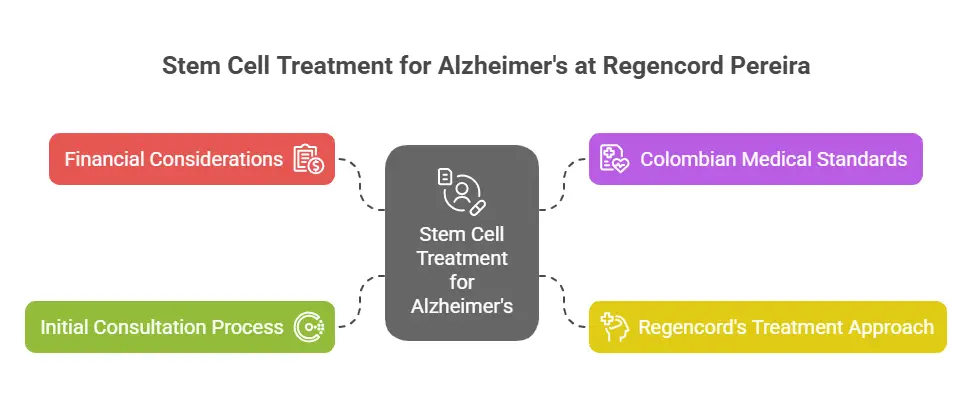Stem cell treatment for Alzheimer’s disease requires a significant financial commitment. Patients typically spend between $20,000 and $30,000 for complex neurological conditions. Many patients now choose international options that provide quality care and economical solutions since these treatments usually require out-of-pocket payments.
Colombian medical facilities have become a premier destination for advanced stem cell therapy, especially for neurological conditions like Alzheimer’s disease. The country’s healthcare centers follow international safety standards and employ well-known experts in cutting-edge stem cell treatments. Colombian medical institutions have earned increasing trust through their expertise and 20-year-old regulatory frameworks.



Alzheimer’s disease represents one of medicine’s most challenging frontiers, progressively deteriorating the brain’s structure and function. Before exploring treatment options, understanding the disease’s fundamental mechanisms helps explain why stem cell treatment for Alzheimer’s disease offers new hope where traditional approaches have shown limited success.
Alzheimer’s disease fundamentally changes brain structure and function through several destructive processes. The disease begins with the formation of two abnormal protein structures: amyloid plaques outside neurons and neurofibrillary tangles inside them. These protein formations aren’t simply byproducts but active contributors to neuronal damage and neurodegeneration.
Amyloid plaques form when a protein called beta-amyloid clumps together between brain cells. These deposits often begin in the hippocampus—the area critical for memory—where they block signals from transferring between cells, essentially cutting off communication and nutrition these cells need to survive.
Simultaneously, tau protein, which normally helps transport nutrients within neurons, collapses and twists into tangled clumps of fibers inside cells. These tangles prevent essential nutrients from reaching brain cells, resulting in cell death and further contributing to neurodegeneration.
As the disease progresses, different brain regions show distinct patterns of damage:
Moreover, the overall brain dramatically shrinks in volume and weight, particularly in the telencephalon. This progressive neurodegeneration eventually impacts basic functions like eating and sleeping as the brain continues to lose neurons and synaptic connections.
Traditional Alzheimer's medications provide only temporary symptom relief without slowing the disease's progression. In contrast, stem cell therapy addresses the fundamental issue of neuronal loss through several mechanisms.
Stem cells offer a revolutionary approach to treating Alzheimer's through three primary pathways. First, they can replace damaged neurons—transplanted neural stem cells can differentiate into various brain cells, including cholinergic neurons, which are heavily affected by Alzheimer's. Second, they provide neuroprotection by releasing growth factors like brain-derived neurotrophic factor (BDNF), which improves cognitive function and promotes neuronal survival. Third, they regulate inflammation and immune responses that contribute to disease progression.
Research in animal models has demonstrated promising results. When neural stem cells were transplanted into Alzheimer's model mice, they improved memory deficits and spatial learning. Other studies show that mesenchymal stem cells (MSCs) can reduce amyloid accumulation by stimulating microglial activation—the brain's primary immune defense. Furthermore, MSCs have been shown to promote the proliferation, differentiation, and maturation of endogenous neural stem cells.
Mesenchymal stem cells and their secreted exosomes play a crucial role in modulating neuroinflammation and promoting neurogenesis. These cells can cross the blood-brain barrier and interact with various cell types in the brain, including astrocytes, microglia, and oligodendrocytes. By regulating the activity of these cells, MSCs and exosomes can help create a more favorable environment for neural repair and regeneration.
Perhaps most encouraging, clinical trials using stem cells for Alzheimer's treatment have begun, with the FDA approving the first MSC trial for Alzheimer's in 2015. These clinical trials are exploring the potential of different types of stem cells, including induced pluripotent stem cells (iPSCs), to address the complex pathology of Alzheimer's disease.
Regencord brings over 30 years of expertise in regenerative medicine, genetics, biotechnology, and pharmacology to their stem cell treatments for Alzheimer's disease. Their approach focuses on personalized treatment plans tailored to each patient's specific needs and disease progression.
At Regencord, stem cell therapy for neurological conditions like Alzheimer's aims to enhance function through a multifaceted approach. Their treatments leverage the regenerative, anti-inflammatory, and immune-regulatory properties of mesenchymal stem cells to address the complex pathology of Alzheimer's disease. This includes targeting key aspects of the disease, such as tau protein accumulation, neuroinflammation, and synaptic dysfunction.
Regencord's treatment protocols often involve the use of mesenchymal stem cells and their derived exosomes. These cells and exosomes have shown promise in modulating the activity of microglia and astrocytes, two types of glial cells that play crucial roles in brain health and disease. By influencing these cells, the treatment aims to reduce neuroinflammation and promote a more neuroprotective environment in the brain.
Safety remains paramount in their protocols. Regencord adheres to strict international standards, including ISO guidelines for biobanking of human mesenchymal stromal cells. This commitment to quality has resulted in positive outcomes for more than 90% of their patients, with no serious adverse events reported.
Through its dedicated focus on neurological conditions, Regencord has positioned itself as a leading provider of advanced stem cell treatments, offering hope where conventional therapies have failed. Its comprehensive approach addresses not just symptom management but also targets the underlying cellular mechanisms of Alzheimer's disease, including promoting neurogenesis and improving cognitive function.

The path to stem cell treatment for Alzheimer’s disease starts with a structured assessment at Regencord Pereira. Your first consultation will provide a foundation for creating a life-changing treatment plan. Our team will gather significant information about your condition and develop the right therapy protocol.
Your treatment begins with a complete review of medical documentation. Patients who want stem cell treatment for Alzheimer’s need to provide these records:
You might need specialized diagnostic tests to confirm Alzheimer's pathology. These tests often include amyloid PET scans or cerebrospinal fluid (CSF) tests that verify amyloid-beta proteins—a hallmark of Alzheimer's disease. Some patients need volumetric MRI scans to assess brain structure. We accept scans completed within six months before consultation.
Lab testing covers complete blood counts, metabolic panels, hormone levels, and screens for conditions that might prevent treatment, including HIV, Hepatitis B, and Hepatitis C. Additionally, biomarkers related to Alzheimer's disease, such as tau protein levels and APOE genotype, may be assessed to provide a more comprehensive understanding of the disease state.
Regencord's medical team follows strict scientific protocols to determine eligibility. They assess several key factors:
Age considerations: Requirements vary among protocols. Many clinical trials focus on patients between 50 and 85 years of age.
Cognitive status: The team uses standardized tests, such as the Mini-Mental State Examination (MMSE), to determine the disease stage. Scores between 20 and 26 are often appropriate for intervention.
Exclusion factors: These conditions typically disqualify candidates:
A reliable study partner or caregiver plays a significant role in treatment eligibility. They help provide valuable insights about symptoms and assist with post-treatment care.
Regencord's specialists develop a custom treatment approach after confirming eligibility. Clinical trials in Alzheimer's have a 99.5% failure rate, mainly due to late intervention and insufficient personalization. That's why Regencord emphasizes precision medicine principles in treatment design.
Your tailored plan has the following:
Patient coordinators guide international travelers through necessary travel documentation and logistics. More than 70% of Regencord's patients come from the United States, and the clinic has unmatched experience supporting international patients.
This detailed consultation process helps create treatment plans that match each patient's unique health profile. This approach gives the best possible outcomes, leveraging the latest advancements in personalized medicine and stem cell research.
After your first consultation and approval for stem cell treatment for Alzheimer's disease, you need to prepare well for your trip to Colombia. Good planning will ensure a smooth experience at Regencord Pereira, allowing you to concentrate on what's most important—your treatment and recovery.
Your trip to Pereira, Colombia, needs careful planning. Make sure your passport has at least six months left before it expires. Most medical visitors must fill out Migración Colombia's Online Check-Mig Form within 72 hours before their flight. U.S. citizens can stay up to 90 days without a visa. In spite of that, anyone needing longer stays for medical treatment should apply for a Special Temporary Visa for Medical Treatment.
Matecaña International Airport in Pereira connects to over 500 global destinations, with direct flights from New York and Miami. This makes reaching your medical destination pretty straightforward. Note that you'll need to arrange transport from the airport to where you're staying—many medical facilities, including Regencord, help with these arrangements.
Pereira has places to stay that fit different budgets and priorities. Medical tourists love the city's comfortable recovery spaces. Here's what you can choose from:
The location near Regencord Pereira should top your priority list. Many properties offer free WiFi, breakfast, and transport services—these extras help a lot during your medical stay. Pereira's mild weather year-round creates the perfect setting for post-treatment recovery and relaxation.
Beyond regular travel items, you should pack these specific things for your medical trip:
Good preparation is key to your comfort during recovery. Pack clothes that work well in Pereira's 17-27°C (63-81°F) temperature range, which stays pretty steady all year.
These preparations are the foundations of a successful stem cell treatment for Alzheimer's experience in Colombia.


Your Alzheimer’s treatment at Regencord Pereira marks a turning point in your healing experience. A clear understanding of each step will help calm your nerves and give you the full picture of this life-changing intervention.
The morning of your stem cell treatment for Alzheimer’s disease involves several preparatory steps. You’ll need to fast for 6-8 hours before the procedure. Small sips of water with essential medications are allowed if your physician permits. Your medical team will run final health checks. These include temperature monitoring and blood tests to make sure you’re ready for treatment.
After you arrive, you'll change into medical attire. The team will clean the treatment area. If they plan stereotactic injections, the medical staff might mark specific sites on Alzheimer's patients. Clean conditions reduce infection risk, so following hygiene instructions is important.
Your doctor will determine the specific protocol for Alzheimer's disease stem cell treatment. Clinical trials show stem cells can be delivered through these routes:
The procedure typically takes several hours. Your medical team monitors your vital signs throughout. Most patients stay awake but sedated during treatment, depending on how the cells are administered.
During the procedure, mesenchymal stem cells or their derived exosomes are introduced into the body. These cells and exosomes can cross the blood-brain barrier, allowing them to reach the affected areas of the brain. Once there, they interact with various cell types, including astrocytes, microglia, and oligodendrocytes, to modulate inflammation and promote a neuroprotective environment.
The recovery phase starts right after your stem cell treatment for Alzheimer's ends. Your medical team will monitor for any adverse reactions. Clinical studies show that patients handle the procedure well, with "no serious adverse events" reported.
The first 24-48 hours include:
Day +1 marks the official start of recovery. Your new cells begin working as your body adjusts to the treatment. Following medical instructions carefully will help you achieve the best results.
The body starts integrating therapeutic cells right after stem cell administration. Recovery begins with careful observation, which plays a vital role in shaping what happens next.
Stem cell treatment for Alzheimer's disease needs minimal downtime for most patients. In spite of that, some temporary reactions may occur in the first week:
Based on clinical observations, these effects usually go away on their own. Regencord's medical team is available through a 24-hour patient hotline if any concerns come up after you leave.
We start tracking progress right after treatment and continue with regular check-ups. Alzheimer's patients usually show cognitive improvements slowly over time.
Most clinics see symptom improvements within weeks to months after Alzheimer's disease stem cell treatment. But it's important to know that stem cell therapy isn't a one-time cure. It helps reduce inflammation and gradually boost neural health.
New monitoring methods have completely changed follow-up care. Doctors can now track transplanted stem cells without invasive procedures using advanced imaging. These tools give us a full picture of cell movement, survival, and function—key information to understand if the treatment works.
Neuroimaging techniques are used to assess changes in brain structure and function over time. This may include monitoring for signs of reduced neuroinflammation, increased neuroplasticity, and improvements in neurotransmitter function. Additionally, cognitive function tests are regularly administered to track improvements in memory, attention, and other cognitive domains.
Regencord has a well-laid-out follow-up system that has:
Check-ups every 3 months to collect data and assess cognitive function. Doctors might adjust treatment plans based on how each patient responds.
Good care goes beyond clinic visits. It includes diet guidance and rehabilitation therapy to help with healing. International patients can use special apps to track their symptoms and vital signs remotely.
Based on these follow-up checks, some patients might need multiple stem cell treatments to get the best results. Multiple treatments often work better than just one, as they can help maintain and enhance the therapeutic effects over time.
Regular talks with your medical team during recovery give you the best chance to get the most from stem cell treatment for Alzheimer's. This ongoing communication allows for personalized adjustments to the treatment plan, ensuring that each patient receives the most effective care possible.
Stem cell treatment for Alzheimer’s disease marks a significant breakthrough in treating this complex neurological condition. Traditional treatments provide limited symptom relief, but stem cell therapy tackles the root causes of neuron loss and degeneration. Regencord Pereira’s complete approach combines decades of expertise with strict safety protocols to give patients access to advanced regenerative medicine.
Clinical evidence points to positive outcomes for most patients who undergo this innovative treatment, though results can vary. The well-laid-out process starts with the original consultation and extends through long-term follow-up care to give each patient customized attention throughout their treatment experience.
Medical science helps us better understand how stem cells can treat Alzheimer’s disease. We have a long way to go, but we can build on this progress as research advances and treatment protocols evolve. Stem cell therapy remains a promising option beyond standard medication. Patients should collaborate with their healthcare providers to check their eligibility and create suitable treatment plans based on their condition.
We focus on knee treatment using stem cell therapy, focusing on three main processes:
Stem cells are unique cells with the ability to develop into various cell types and repair damaged tissues. They are used in regenerative medicine, including treatments for cancer, neurodegenerative diseases, and injuries. Sources include bone marrow, cord blood, and embryos.
(888) 540-4101
Begin your journey with us today! Call us at (888) 540-4101 or complete the form to learn more.


